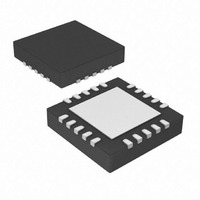PIC16F689-I/ML Microchip Technology, PIC16F689-I/ML Datasheet

PIC16F689-I/ML
Specifications of PIC16F689-I/ML
Related parts for PIC16F689-I/ML
PIC16F689-I/ML Summary of contents
Page 1
... Device ID PIC16F631 142x PIC16F677 132x PIC16F685 04Ax PIC16F687 132x PIC16F689 134x PIC16F690 134x Note 1: The device and revision data is stored in the Device ID located at 2006h in program memory. 2: Refer to the “PIC12F6XX/16F6XX Memory Programming Specification” (DS41204) for detailed information. 2010 Microchip Technology Inc. ...
Page 2
... Overflow may take additional count. 4. Oscillator may stop running at low temps. 5.1 Overflow may take additional count. 5.2 Oscillator may stop running at low temps. 5.3 Sleep in LP mode disables T1OSC. 6. Spurious Reset may occur. (1) Affected Revisions (1) Affected Revisions (1) Affected Revisions 2010 Microchip Technology Inc. ...
Page 3
... PIC16F631/677/685/687/689/690 TABLE 5: SILICON ISSUE SUMMARY (PIC16F687/PIC16F689) Module Feature EUSART Wake-up EUSART Auto-Baud EUSART Auto-Baud EUSART Auto-Baud EUSART Auto-Baud EUSART Reset EUSART Extra Character SSP Start Bit SSP SSPIF Flag ADC/INTOSC Freq. Disturbance Timer1 Ext. Crystal Timer1 Ext. Crystal Timer1 Ext. Crystal ...
Page 4
... After the RCIF flag is set indicating the baud rate has been measured, read the SPBRG register and write the value back to SPBRG. This will terminate the delay, and enable the transmitter module. Fix Rev. A5 Silicon and later revisions. Affected Silicon Revisions PIC16F687/PIC16F689/PIC16F690 2010 Microchip Technology Inc. ...
Page 5
... Work around Before starting auto-baud, clear TXEN. This will reset the transmit state machine correctly. After the auto-baud is complete and the firmware has brought TXEN high, no character will be transmitted. Fix Rev. A5 Silicon and later revisions. Affected Silicon Revisions PIC16F687/PIC16F689/PIC16F690 DS80243M-page 5 will ...
Page 6
... SPI slave with SS pin disabled. Then restore the SSPM bits to the configuration for SPI slave with SS pin enabled. The module is then ready for reception of the following byte. Fix None. Affected Silicon Revisions PIC16F677 A1 X PIC16F687/PIC16F689/PIC16F690 2010 Microchip Technology Inc. ...
Page 7
... C1V REN Note 2010 Microchip Technology Inc. Fix Rev. A5 Silicon and later revisions. The Silicon Rev. A5 (now shipping) and later revision devices have moved the auto-shutdown connection from CxIF to CxOUT. This will eliminate the synchronous shutdown and simplify the use of the comparator for a shutdown event ...
Page 8
... Q1 is held high during Sleep mode. Read CMxCON0 Uncertainty due to Q1 cycle delay C2POL To Data Bus RD_CM2CON0 Set C2IF Q Rev. A4 and previous ECCP Auto-Shutdown Rev. A5: To ECCP Auto-Shutdown 0 SYNCC2OUT MUX to Timer1 Gate, SR latch 1 and other peripherals ). OSC Read CMxCON0 2010 Microchip Technology Inc. ...
Page 9
... Due to the time from Timer1 overflow to the reload being application specific, wait for the timer to increment before beginning the reload sequence. This ensures the timer does not miss a rising edge during reload. Affected Silicon Revisions PIC16F631/PIC16F677 REF A1 X PIC16F685/PIC16F687/PIC16F689/ PIC16F690 DS80243M-page 9 ...
Page 10
... Timer1. On execution of the SLEEP instruction, the oscillator amplifier will be disabled and Timer1 will not be clocked while the device is in Sleep. Work around None. Affected Silicon Revisions will further DD PIC16F631/PIC16F677 A1 X PIC16F685/PIC16F687/PIC16F689/ PIC16F690 2010 Microchip Technology Inc. ...
Page 11
... Modify the TOSE bit in the OPTION register to the opposite configuration for the logic level on the T0CKI pin. 3. Select a prescaler rate other than 1:1 and issue a CLRWDT instruction before switching to the final prescaler rate. Affected Silicon Revisions PIC16F631/PIC16F677 A1 X PIC16F685/PIC16F687/PIC16F689/ PIC16F690 DS80243M-page 11 ...
Page 12
... Pull-up Basic Y ICSPDAT Y ICSPCLK Y — (1) Y MCLR OSC2/CLKOUT Y OSC1/CLKIN Y — Y — Y — Y — — — — — — — — — — — — — — — — — — — 2010 Microchip Technology Inc. ...
Page 13
... Max values. Rev H Document (07/2007) Added Module 4: Analog-to-Digital Converter (ADC) Module. Module 2: Added Fix. 2010 Microchip Technology Inc. Rev J Document (09/2008) Added Module 2.2: Under certain conditions, the SSPIF flag sets on reception of the first byte (under new 2. SSP (PIC16F687/689/690 only)), while changing Module 2. to 2.1. Revised Module 5: LP/ Timer1 Oscillator Operations Below 25° ...
Page 14
... PIC16F631/677/685/687/689/690 NOTES: . DS80243M-page 14 2010 Microchip Technology Inc. ...
Page 15
... PICtail, REAL ICE, rfLAB, Select Mode, Total Endurance, TSHARC, UniWinDriver, WiperLock and ZENA are trademarks of Microchip Technology Incorporated in the U.S.A. and other countries. SQTP is a service mark of Microchip Technology Incorporated in the U.S.A. All other trademarks mentioned herein are property of their respective companies. ...
Page 16
... Fax: 886-3-6578-370 Taiwan - Kaohsiung Tel: 886-7-536-4818 Fax: 886-7-536-4803 Taiwan - Taipei Tel: 886-2-2500-6610 Fax: 886-2-2508-0102 Thailand - Bangkok Tel: 66-2-694-1351 Fax: 66-2-694-1350 2010 Microchip Technology Inc. EUROPE Austria - Wels Tel: 43-7242-2244-39 Fax: 43-7242-2244-393 Denmark - Copenhagen Tel: 45-4450-2828 Fax: 45-4485-2829 France - Paris Tel: 33-1-69-53-63-20 ...



















